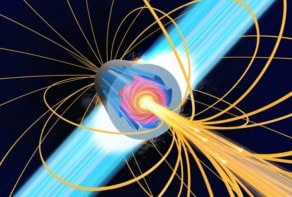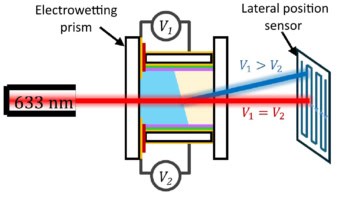
A new type of microwave radio transmitter built by physicists in the US could lead to practical devices that operate at terahertz frequencies – something that could boost the capacity of wireless data systems. The transmitter converts light from a quantum cascade laser into microwave signals and the researchers say that in about five years it could be modified to work in the terahertz range.
Terahertz radiation occupies the notch between microwaves and infrared radiation – at frequencies 100 times higher than those used in today’s wireless data systems. While the effective range of terahertz signals is shorter than microwaves, its higher frequency means that it can carry more information – making it a good candidate for short-range data exchange. The problem, however, is that simple and low-cost ways of creating terahertz radiation are lacking.
Terahertz lasers, for example, typically have to be cooled down to about 80 K and are therefore bulky. Pushing the operational frequency of transistors as high as possible is another option. However, the best performing devices today reach about 0.5 THz, and it remains to be seen how much that limit can be raised.
Laser interference
A more practical approach could be to combine optics and electronics by converting light waves into terahertz signals. The idea is to interfere multiple laser beams with slightly different frequencies to generate an electric current oscillating at the beat frequency that can then feed an antenna. The beat frequency is equal to the difference in frequency of the laser beams.
Systems developed to date have tended to use two relatively large lasers and combine their light in a third device called a photomixer. But in the latest work, Federico Capasso of Harvard University and colleagues have shown how to pull off the same trick using a much more compact set-up centred around a single quantum cascade laser with an optical cavity just a few millimetres long.
Unlike standard semiconductor lasers, which generate photons when electrons and holes combine inside a material with a given band gap, quantum cascade lasers instead comprise a sandwich of dozens of thin layers of semiconductor whose structure determines the output frequency. Each electron that travels through the device “cascades” through a series of quantum wells, emitting multiple infrared photons as it does so. The device can be engineered so that the laser emits over a wide range of infrared frequencies, with the gap between frequencies having a constant, very well-defined value – in this case, within the microwave portion of the electromagnetic spectrum.
Oscillating electric currents
The researchers found that the oscillating electric currents set up by the beating within their laser cavity had a certain spatial distribution. They saw that as the current in one side of the cavity went up, the current in the other went down, and vice-versa. Harvard’s Marco Piccardo says this is like what takes place inside a dipole antenna. Such a device typically consists of two metal wires separated by a short distance, which emit radio waves when driven by an oscillating voltage of opposite phase in the two wires.
To turn their laser into a radio transmitter, the researchers cut a small piece out of the metal electrode that runs along the top of the optical cavity and then connected the two halves of the electrode to strips of gold, each just over a centimetre long and fixed to a dielectric substrate. When supplying current to the laser and placing a microwave horn antenna just under a metre away, they showed that their device emitted microwaves at the beat frequency – which was 5.5 GHz.
Vintage radio
But a radio is only useful if it can transmit information. Piccardo and co-workers showed they could do that by converting an MP3 file of the Dean Martin song “Volare” into a voltage signal that they used to modulate the device’s radiofrequency output. They were then able to pick up the emitted waves and replay the song using a radio receiver, connected to a loudspeaker, that they placed a few metres away. Piccardo says that the transmitted song “had a slight vintage touch” caused by noise at very low frequencies – caused by thermal fluctuations in the laser cavity.
Piccardo emphasizes that the demonstration was a “proof of concept” and that it is likely to take him and his colleagues around five years to adapt the laser and antenna technology so that it transmits powerful signals at terahertz frequencies. For one thing, he says, the spatial pattern of the beating inside the laser will be different at these frequencies. He reckons it could then take another few years to turn the device into a packaged and reliable commercial product. Among the challenges will be bringing the cost down – the growth of quantum cascade laser material being “not cheap”, he says – and shrinking the components as much as possible. “Whether we will be able to put this in a phone,” he says, “I don’t know yet”.
He adds that such a device could have spectroscopy-based applications, in, for example, medicine or radio astronomy.
A preprint describing the radio is on the arXiv server.


